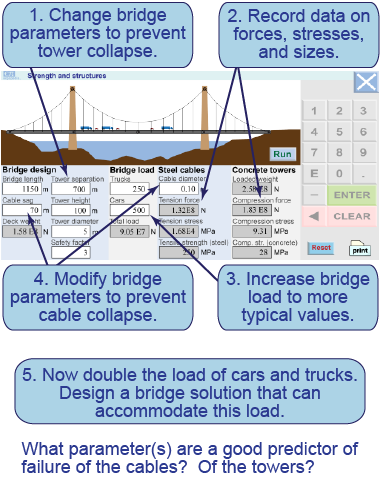| | Essential questions | | How does an engineer design something to be “strong enough”? | |
|
We design buildings and structures to stand up by making sure they don’t fall down. That may seem obvious, but it really isn’t! You cannot design something to stand up under every possible circumstance. The best you can do is to define the possible ways something might fall down and make it strong enough not to fall down under each of your possible scenarios. In practical terms, you design for success by preventing failure! 
|
Design a suspension bridge that will not fail
 The interactive model simulates a suspension bridge with steel support cables and concrete towers. There are many ways that a bridge can fail, but this simulation looks only at two: tensile failure of the cables and compression failure of the towers. The simulation defaults to a bridge with a length similar to that of the Bronx-Whitestone Bridge in New York City but with design parameters that fail.
The interactive model simulates a suspension bridge with steel support cables and concrete towers. There are many ways that a bridge can fail, but this simulation looks only at two: tensile failure of the cables and compression failure of the towers. The simulation defaults to a bridge with a length similar to that of the Bronx-Whitestone Bridge in New York City but with design parameters that fail. - What parameter(s) must you change to prevent the bridge towers from collapsing?
- Record the data on loads, stresses, and sizes.
- Now increase the load on the bridge to a busy day during rush hour, such as 250 trucks and 500 cars.
- How must you change the bridge design to prevent the bridge cables from collapsing? Record the data on loads, stresses, and sizes.
- Double the load of cars and trucks. Come up with a solution so that the bridge does not fail.
- What parameter is a good predictor of failure of the towers? Explain how you know and propose a reason or model for why the towers behave this way.
- What parameter is a good predictor of failure of the cables? Explain how you know and propose a reason for why the cables behave this way.
- What parameter is a good predictor of failure of the towers? Explain how you know and propose a reason or model for why the towers behave this way.
- Devise and carry out a virtual experiment to determine whether the height of the towers has an effect on failure. What is your conclusion? Is there an effect? Propose an explanation using the principles of static equilibrium and describe the component forces that are present to justify your conclusion.
- List at least three additional ways that a suspension bridge might fail.
- Propose at least one design attribute for each of the three failure modes you identified in the last step that would prevent that failure mode from occurring. Explain in one or two sentences why your proposed design feature addresses the failure mode you are trying to prevent.

|
|
In this interactive simulation, you will modify the parameters of a cable suspension bridge that carries cars and trucks. The bridge model is simplified so that you will only consider failure of the towers (due to collapse) or breakage of the suspension cables. The simulation defaults to parameters similar to the Bronx-Whitestone Bridge: length of 1,150 m and tower separation of 700 m.
|
| |
|

